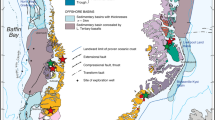Abstract
Two widely-used techniques to estimate the volume of remaining oil and gas resources are discovery process modeling and geologic assessment. Both were used in a recent national assessment of oil and gas resources of the United States. Parallel estimates were obtained for 27 provinces. Geological-based estimates can typically “see” into areas not available to discovery process models (that is areas with little or no exploration history) and thus, on average, yield higher estimates. However, a linear relation does exist between the mean estimates obtained from these two methods. In addition, other variables were found in a multiple regression model that explained much of the difference. Thus, it is possible to perform discovery process modeling and adjust the estimates to yield results that might be expected from geological-based assessments.
Similar content being viewed by others
References
Drew, L. J., and Lore, G. L., 1992, Field growth in the Gulf of Mexico—A progress report,in USGS Research on Energy Resources: U.S. Geological Survey Circular, 1074, p. 22–23.
Drew, L. J., Schuenemeyer, J. H., and Mast, R. F., 1995, Application of the modified Arps-Roberts discovery process model to the 1995 national oil and gas assessment: Nonrenewable Resources, v. 4, no. 3, p. 242–252.
Klemme, H. D., 1983, Field size distribution related to basin characteristics: Oil & Gas Journal, v. 81, no. 52, p. 168–176.
NRG Associates, Inc., 1991 (includes data current as of December 31, 1990), The significant oil and gas fields of the United States: Colorado Springs, CO, Release 7, NRG Associates, Inc. (database available from NRG Associates, Inc., P.O. Box 1655, Colorado Springs, CO 80901).
Petroleum Information Corp., 1993 (includes data current as of December 31, 1992), Well history control system: Littleton, CO, Petroleum Information Corp. (database available from Petroleum Information Corp., 4100 East Dry Creek Road, Littleton, CO 80122).
Schuenemeyer, J. H., and Drew, L. J., 1983, A procedure to estimate the parent population of the size of oil and gas fields as revealed by a study of economic truncation: Mathematical Geology, v. 15, no. 1, p. 145–162.
Schuenemeyer, J. H., and Drew, L. J., 1994, Description of a discovery process modeling procedure to forecast future oil and gas using field growth (ARDS ver. 4.01): U.S. Geological Survey Open File Report 94-113, 216 p.
Schuenemeyer, J. H., and Drew, L. J., submitted for publication, Adjusting oil and gas discovery rate forecasting model for field growth: Journal of the American Statistical Association.
Systat, 1990, SYSTAT Inc., Evanston IL.
U.S. Geological Survey, 1995, 1995 National assessment of United States oil and gas resources: U.S. Geological Survey Circular 1118, 20 p.
Author information
Authors and Affiliations
Rights and permissions
About this article
Cite this article
Drew, L.J., Schuenemeyer, J.H. Oil and gas resource assessment: The linkage between geological analysis and discovery process model results. Nat Resour Res 5, 33–42 (1996). https://doi.org/10.1007/BF02259068
Received:
Revised:
Accepted:
Issue Date:
DOI: https://doi.org/10.1007/BF02259068




